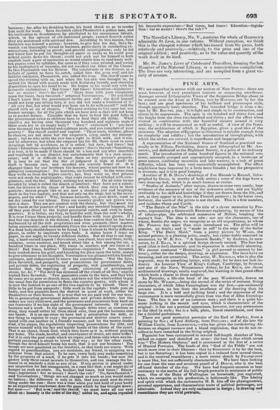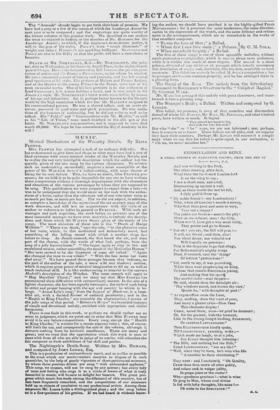FINE ARTS.
WE are somewhat in arrear with our notices of NEW PRINTS: there are none, however, of very prominent interest or surpassing excellence.
Amongst several Lithographic Views of the Suspension Bridge about to be erected over the Avon at Clifton, two by HARDING are by far the best ; and are good specimens of his brilliant and picturesque style, though apparently hasty sketches. The intended bridge is from a de- sign by Mr. BRUNET. jun. : it is light and simple in its construction, and chaste in its appearance. The span is six hundred and thirty feet, and
the height from the river two hundred and thirty ; and the effect when viewed in combination with the beautiful scenery around is very striking : it will be ornamental as well as useful. A view of the Gate- way, the architecture of which is Egyptian, gives a good idea of the structure. The adoption ofEgyptian architecture is suitable enough from its simplicity and solidity ; but the introduction of hieroglyphics, with which the arches are covered, is superfluous and inappropriate.
A representation of the National Games of Scotland as practised an- nually at St. Fillans, Perthshire, drawn and lithographed by Mr. AN- DREWS, and dedicated to the Highland Society, is a print of no ordinary merit. The introduction of some hundred figures in the national cos- tume, naturally grouped and appropriately occupied, in a landscape of great extent, combining mountain and lake scenery, is a task of great difficulty, which has been very successfully accomplished. The effect might have been improved by a little more breadth ; but the perspective is accurate, and it is in good keeping. Another of R. B. DAVIS'S drawings of Fox Hounds in Kennel, litho- graphed by GILES, is worthy of both artists ; some of the dogs have a very knowing look, which is as much human as canine.
" Studies of Animals," after nature, drawn on stone very neatly, bear evidence of the accuracy of eye of the unknown artist, and are highly creditable to his skill and knowledge if they are drawn from the life, and not, as they appear to us, from the Flemish painters ; in the latter case, however, the merit of the prints is not the less. This is a first number, and includes Sheep and Cattle. " The Battle of the Nile" is the title of a clever mezzotint by Pm- Dino, representing a Greenwich Pensioner explaining, by means of bits of tobacco-pipe, the celebrated manoeuvre of Nelson, breaking the enemy's line. The idea is not n4w ; nor are the characters, one of
Whom, Sambo the negro, we recognize as an old acquaintance, to whom Mr. PIDDING has more than once introduced us. The Print will be
popular, no doubt; and is "made to sell" in the reign of the Sailor
King. "The Dairy Maid," from a pretty picture by WARD, the animal painter, is a pleasing print, neatly, but rather feebly executed in mezzotint, by W. R. SAY. G0 A Spanish Bandit," by ZEITTER, in mez- zotint, by J. EGAN, is a spirited design cleverly treated. The face has good (that is bad) character, and its expression is sufficiently alarming.
We cannot commend " Hesitation," (a girl pressed to consent by her lover), either for the design, drawing, or expression. The faces have no meaning, and are unnatural. The artist, W. Nicrioms, who is also the
engraver' may do something better, with study, for he does not lack in- dustry. An Interior View of King's College, Cambridge, by STOnER, and one of the Nave, Westminster Abbey, by La KEUX, are clever architectural drawings, neatly engraved, but wanting in that grand effect which lends a charm to these subjects.
In Portraits, a life-size head of the poet Wordsworth, drawn on stone by Mr. WiLxin,—being the second of the series of eminent living characters, of which Allan Cunningham was the first,—pre-eminently attracts notice, no less from the excellence of the drawing than its large size. It is a bold and striking head ; and the expression of the countenance is more successfully given than was that of Allan Cunning- ham. The face is one of no common man ; and there is a quiet hu- mour lurking in the mouth and eyes, which is characteristic of the original : it has not a poetical appearance, however, nor any pretensions to the ideal in style ; but is a bold, plain, literal resemblance, and thus far a faithful portraiture.
There are good mezzotint portraits of the Earl of Morley, from a painting by SAY; of Lord Althorp, from PRIMPS ; and of the late Sir William Curtis, from LAWRENCE,—who has given the turtle-loving Al. derman an elegant tournure and a bland expression, that we do not re- collect to have remarked in the living original.
Paganini has been caricatured in several full-length sketches of him, etched on copper and sketched on stone: the best is that which terms him " The Modern Orpheus," and is announced as the first of a series
of Musical Portraits. The beads of this "God of the Fiddle" are not much more true in their likeness : that by GREVEDON is by far the best,
but is too flattering; it has been copied in a reduced form several times,
and is the received resemblance ; a more recent sketch by FRANQUINET is more like, but not sufficiently characteristic. We have been looking for one from the neat and accurate pencil of J. DOYLE, who is the best off-hand sketcher of the day. We have had frequent occasion to bear testimony to the merits of his full-length portraits in miniature of public men. One of the Duke of Wellington on horseback, just engraved,
which we recognize as his production, is ludicrously like. The fidelity and spirit with which the caricaturist H. B. hits off the physiognomies,
personal appearance, and characteristic traits of political personages, are admirable. Indeed they are only caricatures in design ; in drawing and resemblance they are vivid portraits.. . . . The "Annuals" already begin to put forth their buds of promise. We have had a peep at a few of the scenes of which the Landscape Annual for meat year is to be composed ; and the engravings are quite worthy of the former volumes. of this popular work. We described to our readers the treat we enjoyed in looking at the sketches of Mr. HARDING for the Landscape Annual; to which, if the engravers do moderate justice, it will he the gem of the series. Peour's were " rough diamonds" of -weight and value ; Ilaitmen's are sparkling brilliants. STANFIELD and PROUT are also in the field ; so that the public will have a rare choice of beauties.



























 Previous page
Previous page